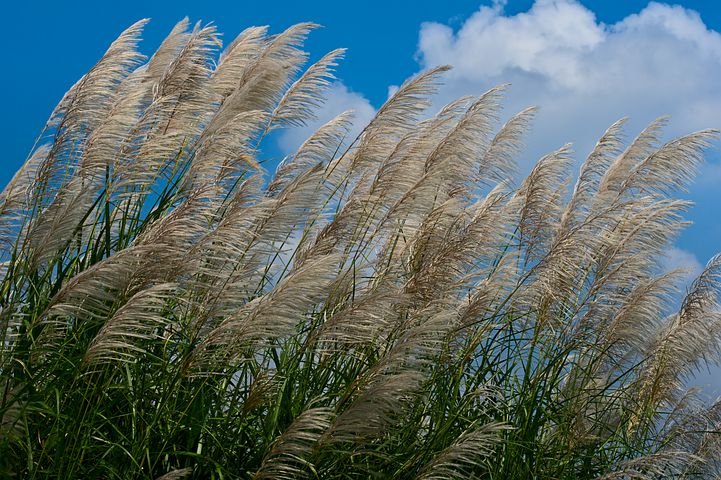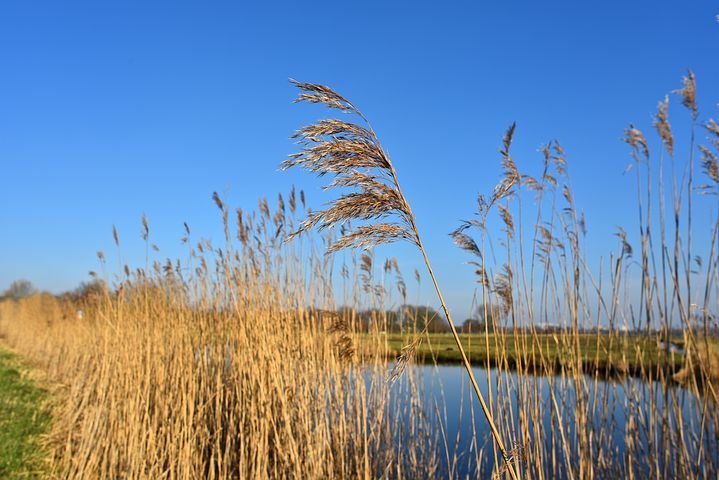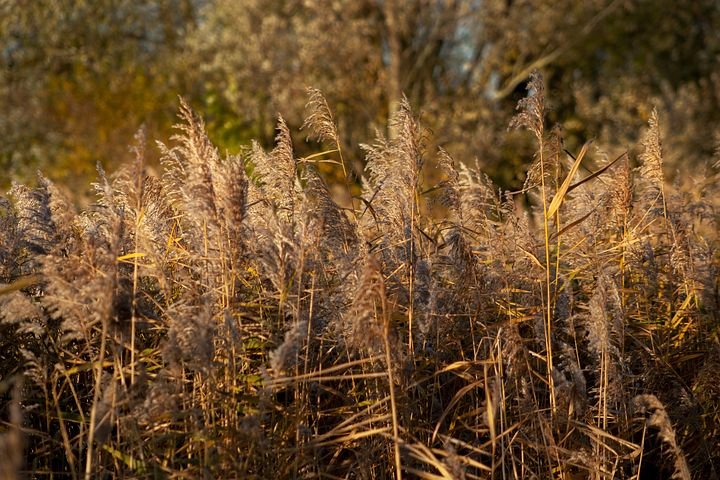Reeds plants are perennial grasses distinguished by having hollow stems and broad leaves. The term refers to grasses in the genera, “Phragmites Arundo, Glyceria, and Phalaris.”
The term is also used to discuss sedges such as papyrus and is sometimes referred to as cattails. The grasses grow in wetlands and can be found throughout the temperate and tropical regions of the world.
Although reeds can be grown from seed, vegetative propagation is much more from rhizomes, and parts of rhizomes are deposited in moving water and can initiate new Reed stands.
What Plant Is A Reed?

The term “Reed” is the general botanical name that is used for tall, grass-like plants of wet places which occur in Reed beds and are all members of the order. It consists of four species constituting the genus Phragmites of the grass family (Poaceas) and the ordinary or water Reed (Phragmites Australis).
Other plants of the family of Poaceae are known as giant Reed (Arundo donax), sea Reed (Ammophila Arenaria), reed canary grass (phalaris), red grass, or blue joint (calamagrostis), bur-reed (sparganium) and rare plants of other families.
1 . Giant Reed

Giant Reed is also known as Arundo donax or giant cane. They are the tall perennial race of the family of Poaceae. It is found in wetlands and habitats and is native to Eastern Asia.
It has a woody tubelike stem that has been used in the manufacturing of flutes and organ pipes. Its source is also used for woodwind instruments.
It is difficult to distinguish the giant reeds from other large seeds, such as the familiar Reed (Phragmites Australis) or the Burma Reed (neyraudia reynaudiana), because of its broader leaf blades.
Uses Of Giant Reed
1 . Giant Reed can be used to manufacture fishing rods, brass musical instruments, canes, and construction supplies.
2 . The Giant Reed can be valuable for wastewater treatment.
3 . The Giant Reed tends to use more water than native plants.
4 . It has some potential as biofuel, which may help to reduce its negative environmental impact outside its native
2 . Common Reed

Common Reed (Phragmites Australis) is the most famous and widely distributed Reed. It can transfer oxygen from its leaves through its stems via its root systems in the gravel bed.
The plants are usually green with yellow nodes during the growing season and yellow when dry in winter. It produces thousands of seeds each year. It varies from year to year, with its seed variability being low.
Uses Of Common Reed
1 . Common Reed can be harvested for making boats, arrows, hunting Spears, rope, snares, medicine, sugar, salt, etc.
2 . Its roots contain up to 5% sugar and can be eaten raw or cooked like potatoes.
3. Powder extracted from the dried stems can be moistened and raised like Marshmallow.
4. Native Americans used familiar Reed for arrow shafts, musical instruments, ceremonial objects, cigarettes, leaves, and stems for constructing mats.
3 . Burma Reed (Neyraudia Reynaudiana)

Burma Reed is commonly known as silk Reed, cane grass, or false Reed. It is a tall, perennial large plumed grass native to Asia and invasive in Southern Florida.
Its flower stalks are from 3 to 15 feet (0.91 to 4.57m) tall, depending on soil and moisture conditions. Burma Reed reproduces by seed and underground stems called rhizomes. It plants flowers twice each year and produces thousands of tiny seeds dispersed by the wind.
Uses Of Burma Reed
1 . Burma Reed is used as a windbreak around crops in Southern Asia.
2 . Its flower plumes are used in flower arrangements.
5 . Sedges

Sedges belong to the flowering plant (Angiosperms) and the Cyperaceae family of plants. They have a single embryonic first leaf that appears from germinating seeds.
Sedges have thick fibrous roots or underground stems, usually with short-spaced internodes.
Uses Of Sedges
1 . Some species of sedges are regarded as important pasture and rangeland plants to provide fodder for domestic animals.
2. Sedges are being used for waterside planting.
3. Its stems are used for weaving household items, construction of boats and houses, thatching, and rope making.
5. Cattails

Cattails (genus Typha) are perennial ants that emerge from creeping rhizomes. They are mainly found in temperate and cold regions of the Northern and Southern hemispheres and are essential to wildlife and many species.
Cattails are also cultivated as pond plants and can spread vigorously through their root systems.
Uses Of Cattails
1 . Cattails can be used in cleaning up an extensive range of toxins that have leached into waterways, such as Phosphorus, methane, and explosives.
2 . The leaves and stalks can be used in making sewn exterior mats for wigwams.
3. They can also be used as bedding, thatching, and in the manufacture of baskets.
Uses and Importance of Reeds
Man has used reeds since prehistoric times. It has been used for thousands of years as a fodder plant in summer, crafts for construction material, pulp, and paper production, and sewage water treatment.
Reeds grow in moist soil, marshes, and shallow waters, and as they grow, they colonize an area and firm a Reed bed. Reed beds create shelter and habitat for several animals, and they are often used in constructed wetlands and can also be used for drawing toxins out of contaminated soil.
1 . Reed As An Industrial Material
As an industrial material, Reed can be used for several purposes ranging from thatching, paper production, manufacturing of construction, and insulation materials.
- Thatching
Thatching is regarded as the best-known use of Reed.
- Construction And Gardening
Reed stems are used to make garden fences, panels and screens, indoor furnishings such as blinds and floor coverings, and the construction of walls, floors, and ceilings of houses. They are also used to produce insulation materials for walls and roofs.
- Pulp And Paper
Reed can be used for paper and pulp production because it has a high proportion of short fibers. Only the leaves must be removed for semi-chemical pulp, and parts of the plants can be used in papermaking.
2 . Reed For Agricultural Purposes
Historically, Reed has been used for centuries for grazing animals and harvested as a fodder plant.
- Fodder
Reed is commonly used as a fodder plant for water buffalo, cows, sheep, cattle, goats, and donkeys.
- Fertilizer/Compost
In agriculture, Reed can be used as a soil conditioner. An example is rice cultivation. Reports have proven that only summer harvested Reed contains sufficient nutrients to be valuable as fertilizer.
3 . Reed For Energy Production
For energy production, Reed can be used in three ways. Namely, combustion, biogas production, and biofuel production.
- Combustion
Heat and power can be generated by combustion or co-combustion of winter harvested Reed with low moisture content. Therefore, the lowest moisture content is achieved by harvesting in late winter.
- Polymerization
Reed can be helpful as a raw material for bio-based plastics.
- Biofuel
Reed is a so-called “second generation” biofuel that helps I’m the production of biofuel. The term ” second generation” is used for biofuels produced from non-food biomass.
- Biogas
Reed releases energy production that digestion may achieve in a biogas plant. Reed harvested in early summer or autumn has a low biogas potential partly due to its higher lignin content.
4 . Reed As Water Treatment
Reed beds are considered the best for water treatments. They are an aquatic plant-based system that allows bacteria, fungi, and microorganisms to break down, digest, and cleans the water to the point where it can fully be discharged.
5 . Reed As Musical Instruments
The giant Reed, also known as Arundo donax, is used as a musical instrument. Ancient Greeks used Arundo donax to make flutes known as “Kalamaulos,” the name which is derived from the Kalamos (cane) + aulos (flute). Arundo donax is a significant source material of Reed makers for clarinets, saxophones, bassoons, bagpipes, and other woodwind instruments.
Frequently Asked Questions
1 . Is Reed Poisonous?
Although Reed is found in the temperate regions of both the Northern and Southern hemispheres, all plant parts are edible and can be cooked or boiled in any season.
2. How Long Do Reeds Take To Grow?
Reeds take roughly seven days for germination to grow, and they are always ready for planting after six weeks.
3 . Where Should I Plant Reed Grass?
Reed grass has a moderate growth rate and should be planted in spring or fall.
4. Can You Eat Water Reeds?
Water Reeds are perfectly edible and are a good form of carbohydrate.
5. How Do I Identify A Reed?
It is pretty easy to identify a Reed. They are flat and strap-like up to two feet long. It can also be identified by its stiff, erect stems and its large silky inflorescence that grows at the top of the stems.
